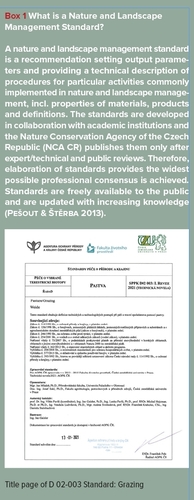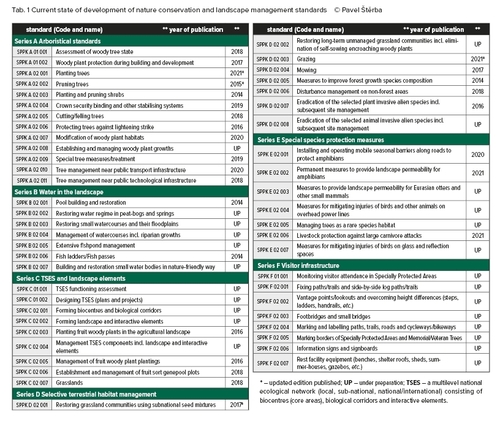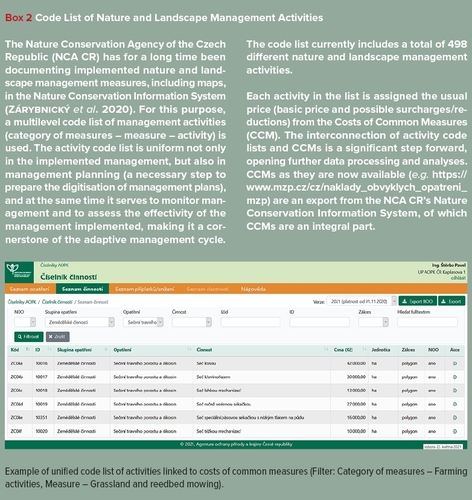Nature Conservation 2022 — 25. 5. 2022 — Nature and Landscape Management — Print article in pdf
Standardization in Nature Conservation and Landscape Management
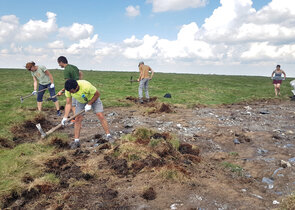
The Nature Conservation Agency of the Czech Republic (NCA CR) has been for ten years elaborating together with academic institutions standards in nature conservation and landscape protection. Almost thirty such standards have been published yet and approx. the same number has been under preparation. Up-to-date experience shows that the concept of standardization in various activities has proved itself successful and has fulfilled its purpose: standards are used by designers, customers, planners, project implementers, contractors, evaluators of application for a subsidy/subvention/grant and they are also applied in the State/Public Administration performance. Moreover, they are sometimes misapplied. Thus, the standards at present have been serving as a basis for establishing unified code lists of activities in nature conservation and landscape protection linked to costs of common measures and consequently for planning and documenting the interventions having been made in nature and the landscape.
The NCA CR started it standardisation of land- scape and management activities in 2010 after discovering that commented instructions (e.g. those issued in the NCA CR methodology series) fail to secure sufficient understanding among all partners and participants in the planning and implementation of practical nature conservation measures. They lacked a clearly defined denominator to which the different actions in the process of prioritisation, setting, assessment, designing, assignment, implementation in the field, acceptance and inspection/checking of practical nature conservation measures can be related (for details, see Pešout & Štěrba 2013).
Although the term standard may be perceived as a synonym of a norm (Knotek 2012), it does not have the intention to be so. It differs in the way standards are developed: in a broad discussion with professionals, details adapted to their future use, and public availability free of charge. Long-term collaboration between state bodies and relevant academic institutions in order to secure continuous updating is also typical of standards (see Box 1).
The standards have become widely used. They help State Nature Conservancy authorities and other investors with defining assignments for designers, formulating the subject of the work, and assessing the work for its acceptance (Knotek 2013). They help State/Public Administration in comparing the effectivity of measures supported. The standards also contribute to a unification of the State/Public Administration performance (Chotěbor 2013).
Current state of standard development
Standards have been developed for over ten years according to an unaltered plan including fixed stages from signing contracts with academic institutions and assembling a development team through development of the content and public and professional reviewing for approval and publication (Pešout & Štěrba l.c.). The documentation of the development of a standard incl. the settlement of remarks is deposited in and available from the public NCA CR library.
Presently, 26 standards have been developed and are published at www.standardy.nature.cz, while other three have been submitted for re- view. Remaining 22 standards have been under development (see Box 2). In 2022, most stand- ards dealing with the most common activities in nature and landscape management should be compiled and published.
During the development of the standards, all participants/stakeholders work together fruitfully, representatives of various opinions and approaches meet, opinions are refined, and concepts and interests are clarified. We appreciate the cooperation with colleagues from academic institutions and other professional collaborators who are willing to work on the development of the standards, just as specialists from reviewing institutions who correct the final form of the standards with their unbiased views. Participation of a broad range of professions, whose involvement is welcomed in the so-called ‘public review’ stage, is very essential.
Updating of the standards
As knowledge progresses and practical experience is gathered in the implementation of measures for nature and the landscape, particular parts of the standards may become obsolete. Therefore the collaboration between the NCA CR and academic institutions is permanent. It is based on mutual interest in keeping the standards up to date. Thus, although some standards have not been finished yet, the first ones have already been updated.
An example of an updated standard is Planting Trees (SPPK A 02 001). Another one is a standard dealing with grazing (SPPK D 02 003), where amendments to it were evoked by the need to adopt a standard for livestock protection against large carnivore attacks (SPPK E 02 006), which had initially not been planned. This shows that not only existing standards need updating, but also completely new ones must be added. There, a new set of measures caused by the return of large carnivores to a large area in the Czech Republic needed to be implemented in the field. Similarly, standardisation of fire management is assumed to be necessary in the future (as a supplement to the already published SPPK D 02 006 standard titled Disturbance Management on Non-forest Areas) if the presently discussed amendment to the Nature Conservation and Landscape Protection Act is approved, enabling the burning of vegetation in the selected cases.
Standards and costs of common measures
Ten years ago, NCA CR also started to produce documents named Costs of Common Measures (CCM), at the time titled Pricelists of Common Measures of the NCA CR. The reason was the adoption of a new Administrative Procedure Code and the 2010 ruling of the Constitutional Court, which helped to put into effect agreements on farming methods with landowners according to Article 68 of the Nature Conservation and Landscape Protection Act, to implement measures for the improvement of the natural environment, and to refrain from selected activities in the form of public contracts (Pešout & Šmídová 2012). Until then, all measures had been assigned in the form of services and the price was determined in accordance with public procurement regulations. According to the farming agreements, however, contributions were paid pursuant to Article 69. Therefore the mentioned Pricelists of Common Measures was compiled, based on averages of supplier prices at that time, which secured a comparable payments for implementing similar measures across various regions. Based on a recommendation of the Czech Republic Supreme Audit Office, the experience was later taken over by the Ministry of the Environment of the Czech Republic to ensure comparable practice in areas not falling under the NCA CR administration. Since then, the Ministry has issued CCMs every year. They are updated according to experience of State Nature Conservancy authorities and from practice in the comment process. Exceptionally (for new, formerly not commonly implemented measures) a CCM is compiled in another way (e.g. by targeted survey or research).
As the standards are developed and published, they are gradually linked to the CCMs. Its aim is to standardise activities in procedure, conditions and materials traceable in the CCMs and conversely. For example, once the arboriculture standard (SPPK A 02 002) was published, the structure and names of measures in the relevant part of the CCM were completely changed to be consistent with the published standard. In the different chapters of the current version of CCM (2021) also the related standards are mentioned.
Box 1 What is a Nature and Landscape Management Standard?
Table 1 Current state of development of nature conservation and landscape management standards © Pavel Štěrba
* – updated edition published; UP – under preparation; TSES – a multilevel national ecological network (local, sub-national, national/international) consisting of biocentres (core areas), biological corridors and interactive elements.
Standards and activity code lists
The standards are gaining in importance because of the introduction of active adaptive management (AM) in Specially Protected Areas (Pešout & Knižátková 2020). A prerequisite for continuously updated administration and management is the necessary digitisation of the entire AM cycle from planning, setting targets and their prioritisation, administration and implementation to monitoring the state of the subject of conservation and assessing how well management and conservation goals have been achieved. A tool making this possible is a unified nature conservation information system, which has currently been under preparation (Zárybnický et al. 2020). This approach requires unification of the different code lists, such as the code list of nature and landscape management activities (see Box 2), in order to make clear what activities are meant by a certain term. The nature and landscape manage- ment standards serve as a basis for elaborating such code lists.
Box 2 Code List of Nature and Landscape Management Activities
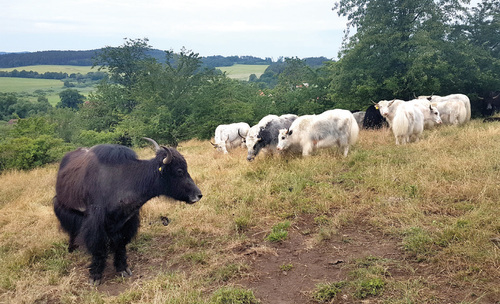
Standard D 02-003 Grazing was amended in 2021. Grazing on Štítarský kopec Hill sub-national Territorial System of Ecological Stability (TSES) biocentre/core area carried out by the Czech Union for Nature Conservation, Libosváry Local Chapter. © Pavel Pešout
Standardisation must not limit individual approaches
The objective of the standards is not only to unify terms in the communication among designers, investors, suppliers, the State/Public Administration and experts and technical institutions, but also to achieve the required quality in nature and landscape management. The standards are based on examples of good practice, therefore respecting them should guarantee correct and appropriate implementation of a project.
At the same time, however, it must be stressed that each measure has to be considered individually, taking into account specific local conditions. It is possible or rather certain that conditions and procedures set in a standard will have to be altered in the particular cases. In such a situation, thoughtless insisting on consistent application of the standard is one of the mistakes made in applying standards. On the other hand, a decision to deviate from the standard procedure must be made consciously, and in internal NCA CR practice also described and justified. Documentation of an aberrant procedure is not only important for a particular situation, but it also (especially when repeated) is an incentive to update the standard. It is moreover important in the checking payments from subvention programmes/subsidy schemes guaranteed by the Ministry of the Environment of the Czech Republic.
Standards should thus – whether for convenience or caution – not make the land manager or another supplier or work assessor stop considering or even ignore specific conditions at the implementation site and so make less effort in setting the parameters of the measure as targeted and tailored as possible to achieve the best possible result.
The standards in nature and landscape management can only support the appropriate implementation of the measures, but they alone cannot ensure adequate quality. Therefore, they should be handled as a utility or a tool, not as a law. ■
- - -
Intro photo: Grass sod/turf removal is included in nature and landscape management standard D 02 006 Disturbance Management on Non-forest Areas. The photograph shows topsoil grass sod/turf Vysoká hole in the Praděd/Altvater National Nature Reserve, 2019. © Pavel Pešout
- - -
List of referencies
Chotěbor P. (2013): Možnosti využití standardů v praxi ČIŽP. Sborník přednášek
z odborného semináře „Standard v oboru arboristika 2013“: 8-11. MendelU Brno,
AOPK ČR Praha.
Knotek J. (2012): Standardizace v oboru – legislativa. Sborník přednášek z odborného
semináře „Standard v oboru arboristika 2012“: 5-11. MendelU Brno, AOPK ČR Praha.
Knotek J. (2013): Využití oborových standardů ve výběrových řízeních. Sborník přednášek
z odborného semináře „Standard v oboru arboristika 2013“: 23-27. MendelU Brno,
AOPK ČR Praha.
Pešout P., Knižátková E. (2020): Adaptivní management chráněných území ve správě
AOPK ČR. Ochrana přírody 6:20-25.
Pešout P., Štěrba P. (2013): Standardy péče o přírodu a krajinu. Ochrana přírody 3:8-10.
Pešout P., Šmídová L. (2012): Veřejnoprávní dohody s vlastníky skutečností. Ochrana
přírody 5:14-15.
Zárybnický J., Pešout P., Chobot K. (2020): Datová podpora veřejné správy v ochraně
přírody a krajiny zajišťovaná AOPK ČR. FOP 4:6-10.


